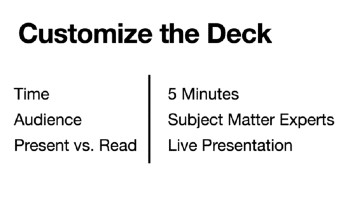 Thursday, July 23, 2020 Thursday, July 23, 2020 5 Steps to a Killer PitchBy: Lance Cottrell, North Bay Angels Editors Note - The following article shares points from one investor to founders. ACA wants to know – does your group have similar expectations? Or, do you have additional advice for founders who pitch to your group? I answer more questions and provide more coaching about investor pitches than anything else. Once you decide that you need investment to grow your company, your task as a founder is to convince investors to give it to you. The first step in that process is a pitch, and getting it right is essential to the future of your business. In this blog, I will share with you my five-step process for building a killer pitch. These steps are a process, not a recipe. I don’t have template slides where you just fill in the blanks because we are not playing Mad Libs. Your pitch needs to be unique and crafted to highlight your company’s strengths and relative advantages. As you create your deck consider its purpose and your objective. It exists to get you the next meeting, nothing more. If you generate enough interest and excitement to move forward with due diligence, you have succeeded.
The five steps are:
1 - Gather Start by pulling together all the information that your deck will probably require. Jot down your answer to each of the following questions. Some may require time, research, and analysis to answer well. You can find a link to a worksheet with all five steps and these questions in the description.
If you don’t have satisfying answers to these questions, you might not be ready to pitch. It would be better to spend time researching, testing, and refining the business rather than pushing forward with developing your deck. With most investors, you only get one bite at the apple. Don’t waste it by going in half-assed. 2 - Focus Now that you have all the information that might go into your deck, you need to bring some focus to your presentation. Try to highlight what your audience needs to hear, not what you like to talk about. I have a blog on the nine things angel investors look for in startup fundraising pitches. Try to keep your explanations at a high level. If the audience wants to know more, they can ask questions or dig deeper in due diligence. Don’t get into the technical details of your product unless it is absolutely required. On the other hand, DO state the obvious. Things about your business or market that are obvious to you may not be to most investors.
Thinking of your business as a whole, and referencing the list you made in step 1, what are the best things about your startup? Do you have any business superpowers? What are your particular strengths or aspects that make you stand out? Make a note of that to ensure you highlight it during the pitch. Then, look for a few other things about your company that the audience must understand and remember. Limit yourself to just a few. After a few days, most people only retain 3-5 items from a presentation. Choose yours carefully and make them count. Look for and remove details or trivia that does not need to be in the deck. If the investor does not need to know something to understand your business at a 60,000 ft level, it should go. Every slide, every word, every idea, needs to fight for existence in your pitch. Be brutal in your focus. 3 - Organize Now you need to pull all those ideas into a coherent structure. A pitch is just a special kind of presentation. For a deeper dive into presentations and presenting in general, check out my hour-long presentation training video. You won’t be able to get away with creating just one deck. Different contexts require different decks. One size will not fit all. You will frequently need to adjust your deck to fill the amount of time they give you. You should never need to rush or stall to hit your allotted time.
You will also need to customize your deck for each audience. If you are addressing a random group of angel investors, you will need to explain some things that are blindingly obvious to you. However, if it is a group of industry experts, they might be insulted by that kind of remedial level information but want to see more details of your solution. Finally, and I have ranted about this in a past blog, create different decks for presenting in-person vs. emailing to be read alone. I want to make a radical suggestion; resist the urge to start using any kind of presentation software at this point. I use 3X5 cards, mind maps, or sticky notes to organize my presentations.
The key is making it as easy as possible to reorganize your deck. You need to be able to see everything all at once and shuffle it around with zero effort. For simplicity, I will just talk about my process with cards. Another advantage of jotting just a couple of words on each card is that you can cultivate a Buddhist detachment towards them. You spent no time making them, so it is easy to rip them up and replace or change them. Keep the process as frictionless as possible. Capture on the cards all the information you decided to keep in the presentation and lay them out in what seems like a reasonable order. Mark the headline and key point cards so you can see if they are getting the emphasis you want. The first and last things an audience hears will be the most memorable and carry the greatest impact. If you can, put your headline in one or both of those places. I wrote a blog on nailing the start of your pitch.
Think about your pitch as a story. Narrative is far more memorable than data, particularly if you invest it with emotion. Is there a way of organizing your presentation so that it tells a story about you or your customers? It could be a story about how you came to found the company or a story about a real or imagined customer. One of my portfolio companies created a children’s picture book to illustrate their product and found it to be incredibly effective in all kinds of contexts. Try to connect all the content in your pitch with a single thread running throughout the presentation. Next, consider the transitions between each concept. Walk through the cards in order and think about what you will say as you advance through them. Does each one follow logically from the one before? Do they build a narrative? Do you make any statements or claims before showing the supporting information or context to understand them? You may need to change the order, add, or remove cards to make things flow smoothly Now, start practicing the pitch. Do it right from the cards while everything is still easy to change. Present or read (depending on whether it is a delivered or emailed deck) all the way through, making notes and changes as you go. Continue to feel for those awkward transition points. Look for places where the pace drags. Notice if you are spending too much time on less important things. Check whether the key points stand out and are positioned for maximum impact. Fix the problems you found, then do it again and again until it feels good. 4 - Build In many ways, this is the easy part. You know all the slides that will be in the deck, why they are there, and what you will say about them. Now, go create those slides. I usually start by making a blank slide with the tiny bit of text that was on each card. From there, I start zeroing in on the exact content for the slide, of which there should not be much. Slides must be clean and uncluttered, even for read-alone decks. For delivered presentations, the audience must be able to read it from across the room in a couple of seconds. When someone is reading a slide, they are not hearing what you are saying. Your spoken words carry much more weight than the text on the slide.
In a presentation, slides only exist to support and enhance your words. They need not, and should not, stand alone. Steve Jobs was a master of this. When he introduced the new MacBook Air, he talked about how small it was, not with numbers but by pulling it out of a mailing envelope. And the computer on an envelope was all you saw on the screen behind him. Focusing on and reinforcing that one concept made it memorable. Every article written on the launch used that example. If you have enough artistic talent to make the deck look fantastic, great, get to work! If not, mockup the slides, create rough diagrams, and find appropriate graphics or images. Then hand it off to a designer who can make it look professional. With all the content planned out and prepared, it should not cost much to get it looking fabulous. 5 - Polish Now is the time to start polishing your pitch to a fine edge. If you will be delivering the pitch verbally, whether in person, video conference, or recording, make sure you know the content inside and out. Don’t memorize the words you will say, but rather the message you want to deliver. Internalize the point and purpose of every slide. A memorized presentation often feel awkward, wooden, and over-rehearsed. The only exception is the opening, which can lead to stumbles, so knowing the first few sentences word for word can help. Practice until you can consistently deliver the pitch, in your improvised words, within the time limit. Next, get feedback from as many people as you can. Ideally, use people who are not familiar with your company, so they better reflect the mental state of your real audience. Find people who are willing to hurt your feelings. You want them to tell you, in great detail, why your baby is ugly. Embrace the power of frank feedback. For read-alone decks, let them read it without you in the room. For presentation, present just like you would in the real meeting. Afterward, don’t just ask what they thought about your pitch, pose specific questions.
Lather – Rinse – Repeat. Keep improving the deck and showing it to new audiences. This process never stops. No pitch is perfect, you can always find ways to improve it, and your company will be continually evolving, requiring you to adapt your content. Pitch Pitching is not your core business, so it seems unfair that your success or failure could depend on something so unrelated. But it does. Your pitch needs to be amazing because the competition is intense. I see lots of good companies fail to raise funds because of weak presentations. As hard and wasteful as it can sometimes seem, take the time and invest the effort to make yours sing. You may even find that this process helps clarify your thinking about the business. If you use this process to build or revise your deck, I would love to take a look. As an incentive, I will give the first ten submissions detailed feedback over a coaching call. Warning, I am one of those people willing to tell you that your baby is ugly, sometimes in gory detail. About Lance Cottrell: I am an entrepreneur, investor, advisor, and mentor. Many of those I help call me “The Boot” because I always have one in their rear pushing them forward. In the process, I have learned a tremendous amount about starting companies, raising capital, and angel investing. I can’t wait to share it all with you! My approach is strongly influenced by my background in physics. I tend to look at problems from a scientific perspective and strive to fully understand all the mechanisms involved. Visit Feel the Boot for more information. |









